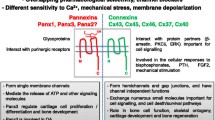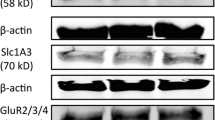Abstract
Osteoblasts were previously reported to form tight junctions, which may play an important role in the regulation of ion transport across the epithelial-like bone membrane. However, the evidence for the presence of tight junction-associated proteins in osteoblasts is lacking. We therefore studied the expression of tight junction-associated genes in primary rat osteoblasts and bone tissues. Quantitative real-time PCR showed that osteoblasts expressed ZO-1, -2, -3, cingulin, occludin, claudin-1 to -12, -14 to -20, -22 and -23. By using western blot analyses of selected claudins, expression of claudin-5, -11, -14 and -15, but not claudin-3, were identified in osteoblasts. A confocal immunofluorescent study in undecalcified tibial sections confirmed that claudin-16 was localized on the trabecular surface, normally covered by osteoblasts and bone-lining cells. In addition, immunohistochemical studies in decalcified tibial sections demonstrated the expression of claudin-5, -11, -14, -15 and -16 in bone-lining cells (inactive osteoblasts). Primary osteoblasts cultured in the Snapwell for 19–26 days were found to form a monolayer with measurable transepithelial resistance of ∼110–180 Ωcm2, confirming the presence of barrier functions of the tight junction. It was concluded that osteoblasts expressed several tight junction-associated proteins, which possibly regulated ion transport across the bone membrane.







Similar content being viewed by others
References
Angelow S, El-Husseini R, Kanzawa SA, Yu AS (2007) Renal localization and function of the tight junction protein, claudin-19. Am J Physiol Renal Physiol 293:F166–F177
Armstrong WD, Singer L (1965) Composition and constitution of the mineral phase of bone. Clin Orthop Relat Res 38:179–190
Bakker A, Klein-Nulend J (2003) Osteoblast isolation from murine calvariae and long bones. In: Helfrich MH, Ralston SH (eds) Methods in molecular medicine: bone research protocols. Humana Press, New Jersey, pp 19–28
Ben-Yosef T, Belyantseva IA, Saunders TL, Hughes ED, Kawamoto K, Van Itallie CM, Beyer LA, Halsey K, Gardner DJ, Wilcox ER, Rasmussen J, Anderson JM, Dolan DF, Forge A, Raphael Y, Camper SA, Friedman TB (2003) Claudin 14 knockout mice, a model for autosomal recessive deafness DFNB29, are deaf due to cochlear hair cell degeneration. Hum Mol Genet 12:2049–2061
Bushinsky DA, Chabala JM, Levi-Setti R (1989) Ion microprobe analysis of mouse calvariae in vitro: evidence for a “bone membrane”. Am J Physiol 256:E152–E158
Bushinsky DA, Riordon DR, Chan JS, Krieger NS (1997) Decreased potassium stimulates bone resorption. Am J Physiol 272:F774–F780
Charoenphandhu N, Tudpor K, Pulsook N, Krishnamra N (2006) Chronic metabolic acidosis stimulated transcellular and solvent drag-induced calcium transport in the duodenum of female rats. Am J Physiol Gastrointest Liver Physiol 291:G446–G455
Charoenphandhu N, Wongdee K, Tudpor K, Pandaranandaka J, Krishnamra N (2007) Chronic metabolic acidosis upregulated claudin mRNA expression in the duodenal enterocytes of female rats. Life Sci 80:1729–1737
Citi S, Amorosi A, Franconi F, Giotti A, Zampi G (1991) Cingulin, a specific protein component of tight junctions, is expressed in normal and neoplastic human epithelial tissues. Am J Pathol 138:781–789
Furuse M, Tsukita S (2006) Claudins in occluding junctions of humans and flies. Trends Cell Biol 16:181–188
Greger R (1996) Epithelial transport. In: Greger R, Windhorst U (eds) Comprehensive human physiology: from cellular mechanisms to integration. Springer, Berlin, pp 1217–1232
Guillemot L, Citi S (2006) Cingulin regulates claudin-2 expression and cell proliferation through the small GTPase RhoA. Mol Biol Cell 17:3569–3577
Hirano T, Kobayashi N, Itoh T, Takasuga A, Nakamaru T, Hirotsune S, Sugimoto Y (2000) Null mutation of PCLN-1/Claudin-16 results in bovine chronic interstitial nephritis. Genome Res 10:659–663
Ikari A, Hirai N, Shiroma M, Harada H, Sakai H, Hayashi H, Suzuki Y, Degawa M, Takagi K (2004) Association of paracellin-1 with ZO-1 augments the reabsorption of divalent cations in renal epithelial cells. J Biol Chem 279:54826–54832
Inoko A, Itoh M, Tamura A, Matsuda M, Furuse M, Tsukita S (2003) Expression and distribution of ZO-3, a tight junction MAGUK protein, in mouse tissues. Genes Cells 8:837–845
Jantarajit W, Thongon N, Pandaranandaka J, Teerapornpuntakit J, Krishnamra N, Charoenphandhu N (2007) Prolactin-stimulated transepithelial calcium transport in duodenum and Caco-2 monolayer are mediated by the phosphoinositide 3-kinase pathway. Am J Physiol Endocrinol Metab 293:E372–E384
Kostenuik PJ (2005) Osteoprotegerin and RANKL regulate bone resorption, density, geometry and strength. Curr Opin Pharmacol 5:618–625
Kriegs JO, Homann V, Kinne-Saffran E, Kinne RK (2007) Identification and subcellular localization of paracellin-1 (claudin-16) in human salivary glands. Histochem Cell Biol 128:45–53
Lehr HA, van der Loos CM, Teeling P, Gown AM (1999) Complete chromogen separation and analysis in double immunohistochemical stains using Photoshop-based image analysis. J Histochem Cytochem 47:119–126
Marenzana M, Shipley AM, Squitiero P, Kunkel JG, Rubinacci A (2005) Bone as an ion exchange organ: evidence for instantaneous cell-dependent calcium efflux from bone not due to resorption. Bone 37:545–554
Markov AG, Shadrin LV, Veshnyakova AU, Amasheh S, Fromm M (2006) The tight junction proteins claudin-2 and -16 expression in mammary epithelium of mice. Ross Fiziol Zh Im I M Sechenova 92:1382–1386
McCarthy KM, Francis SA, McCormack JM, Lai J, Rogers RA, Skare IB, Lynch RD, Schneeberger EE (2000) Inducible expression of claudin-1-myc but not occludin-VSV-G results in aberrant tight junction strand formation in MDCK cells. J Cell Sci 113:3387–3398
McNeil E, Capaldo CT, Macara IG (2006) Zonula occludens-1 function in the assembly of tight junctions in Madin–Darby canine kidney epithelial cells. Mol Biol Cell 17:1922–1932
Owen TA, Aronow M, Shalhoub V, Barone LM, Wilming L, Tassinari MS, Kennedy MB, Pockwinse S, Lian JB, Stein GS (1990) Progressive development of the rat osteoblast phenotype in vitro: reciprocal relationships in expression of genes associated with osteoblast proliferation and differentiation during formation of the bone extracellular matrix. J Cell Physiol 143:420–430
Peterson DR, Heideger WJ, Beach KW (1985) Calcium homeostasis: the effect of parathyroid hormone on bone membrane electrical potential difference. Calcif Tissue Int 37:307–311
Prêle CM, Horton MA, Caterina P, Stenbeck G (2003) Identification of the molecular mechanisms contributing to polarized trafficking in osteoblasts. Exp Cell Res 282:24–34
Rubinacci A, Benelli FD, Borgo E, Villa I (2000) Bone as an ion exchange system: evidence for a pump-leak mechanism devoted to the maintenance of high bone K+. Am J Physiol Endocrinol Metab 278:E15–E24
Rubinacci A, Covini M, Bisogni C, Villa I, Galli M, Palumbo C, Ferretti M, Muglia MA, Marotti G (2002) Bone as an ion exchange system: evidence for a link between mechanotransduction and metabolic needs. Am J Physiol Endocrinol Metab 282:E851–E864
Saitou M, Furuse M, Sasaki H, Schulzke JD, Fromm M, Takano H, Noda T, Tsukita S (2000) Complex phenotype of mice lacking occludin, a component of tight junction strands. Mol Biol Cell 11:4131–4142
Shu C, Li TY, Tsang LL, Fok KL, Lo PS, Zhu JX, Ho LS, Chung YW, Chan HC (2006) Differentiation of adult rat bone marrow stem cells into epithelial progenitor cells in culture. Cell Biol Int 30:823–828
Simon DB, Lu Y, Choate KA, Velazquez H, Al-Sabban E, Praga M, Casari G, Bettinelli A, Colussi G, Rodriguez-Soriano J, McCredie D, Milford D, Sanjad S, Lifton RP (1999) Paracellin-1, a renal tight junction protein required for paracellular Mg2+ resorption. Science 285:103–106
Trumbore DC, Heideger WJ, Beach KW (1980) Electrical potential difference across bone membrane. Calcif Tissue Int 32:159–168
Van Itallie CM, Anderson JM (2006) Claudins and epithelial paracellular transport. Annu Rev Physiol 68:403–429
Van Itallie C, Rahner C, Anderson JM (2001) Regulated expression of claudin-4 decreases paracellular conductance through a selective decrease in sodium permeability. J Clin Invest 107:1319–1327
Van Itallie CM, Fanning AS, Anderson JM (2003) Reversal of charge selectivity in cation or anion-selective epithelial lines by expression of different claudins. Am J Physiol Renal Physiol 285:F1078–F1084
Van Itallie CM, Rogan S, Yu A, Vidal LS, Holmes J, Anderson JM (2006) Two splice variants of claudin-10 in the kidney create paracellular pores with different ion selectivities. Am J Physiol Renal Physiol 291:F1288–F1299
Weinger JM, Holtrop ME (1974) An ultrastructural study of bone cells: the occurrence of microtubules, microfilaments and tight junctions. Calcif Tissue Res 14:15–29
Yu AS, Enck AH, Lencer WI, Schneeberger EE (2003) Claudin-8 expression in Madin–Darby canine kidney cells augments the paracellular barrier to cation permeation. J Biol Chem 278:17350–17359
Zhang X, Yang M, Lin L, Chen P, Ma KT, Zhou CY, Ao YF (2006) Runx2 overexpression enhances osteoblastic differentiation and mineralization in adipose-derived stem cells in vitro and in vivo. Calcif Tissue Int 79:169–178
Acknowledgments
This research was supported by grants from the Strategic Consortia for Capacity Building of University Faculties and Staff, Commission on Higher Education, Thailand (to K.W.), and the Thailand Research Fund (to N.C. and N.K.).
Author information
Authors and Affiliations
Corresponding author
Rights and permissions
About this article
Cite this article
Wongdee, K., Pandaranandaka, J., Teerapornpuntakit, J. et al. Osteoblasts express claudins and tight junction-associated proteins. Histochem Cell Biol 130, 79–90 (2008). https://doi.org/10.1007/s00418-008-0419-6
Accepted:
Published:
Issue Date:
DOI: https://doi.org/10.1007/s00418-008-0419-6




